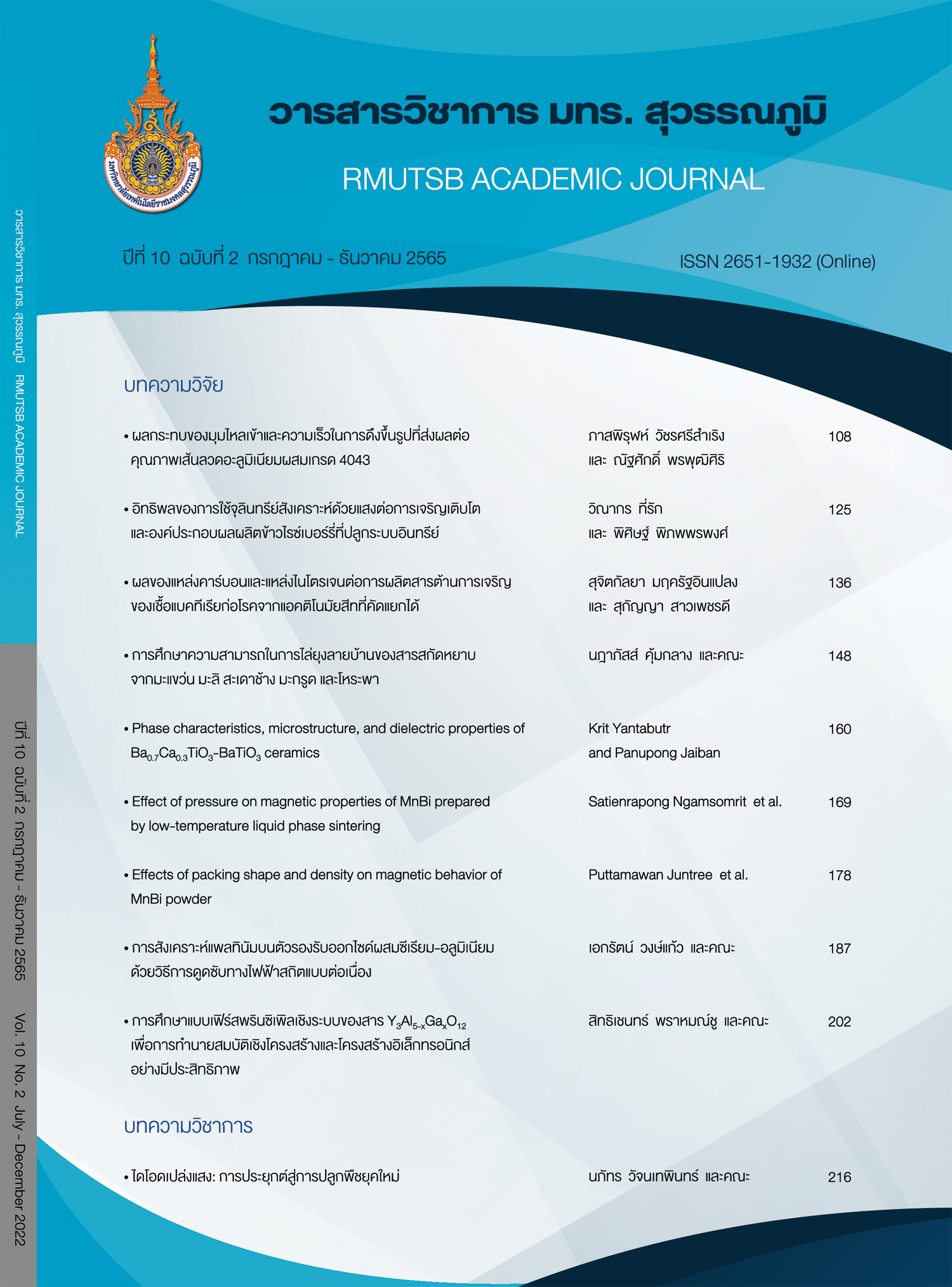Study of the repellent efficacy against Aedes aegypti L. of crude extracts from Zanthoxylum limonella Alston., Jasminum sambac Ait., Azadirachta excelsa (Jack) Jacobs., Citrus hystrix DC. and Ocimum basilicum L.
Main Article Content
Abstract
This study aimed to determine the effectiveness of the crude extracts from Zanthoxylum limonella Alston. (seed), Jasminum sambac Ait. (flower), Azadirachta excelsa (Jack) Jacobs. (seed), Citrus hystrix DC. (peel) and Ocimum basilicum L. (leaves) in repellency against Aedes aegypti (L.). These five herbs were extracted by Soxhlet extraction and maceration methods using distilled water and 95% ethanol as solvents. The repellent efficacy of the studied crude extracts were compared with DEET at concentration of 15×104 ppm. The results were showed that the highest percentages of mosquito repellent activity in the study was Z. limonella seed extracted at the concentration of 10×104 ppm with Soxhlet extraction using ethanol as solvent, resulting in mosquito repellent activity of 86.04%, followed by the extracts from A. excelsa, C. hystrix, O. basilicum and J. sambac, showing the mosquito repellent activity of 79.11, 68.87, 65.15 and 62.77%, respectively. The crude extracts were applied to produce mosquito repellent lotion, and the lotion was tested by the human volunteers and found that could prevent mosquitoes bites for 60 min.
Article Details

This work is licensed under a Creative Commons Attribution-NonCommercial-NoDerivatives 4.0 International License.
Published manuscript are the rights of their original owners and RMUTSB Academic Journal. The manuscript content belongs to the authors' idea, it is not the opinion of the journal's committee and not the responsibility of Rajamangala University of Technology Suvarnabhumi
References
Barnard, D. R., Bernier, U. R., Xue, R., & Debboun, M. (2007). Standard methods for testing mosquito repellents. In M. Debboun, S. P. Frances, & D. Strickman (Eds). Insect repellents: Principles, methods and uses (pp. 103-110). Florida: CRC Press.
Bureau of Cosmetics and Hazardous Substances. (2010). Insect repellents. Retrieved 15 July 2019, from http://e-library.dmsc.moph.go.th/ebooks/files/insect.pdf (in Thai)
Chompoosri, J. (2010). Mansonia spp; Malayan filariasis vectors. In U. Thavara (Ed.), Biology ecology and mosquito control in Thailand (pp. 98-106). Nonthaburi: National Institute of Health of Thailand. (in Thai)
Debboun, M., Frances, S. P., & Strickman, D. (2007). Insect repellents: Principles, methods and uses. Boca Raton: CRC Press.
Division of Complementary and Alternative Medicine. (2007). Aromatherapy. Retrieved 16 July 2019, from https://
thaicam.go.th/aromatherapy (in Thai)
James, H. D. (2016). Chemical and plant-based insect repellents: Efficacy, safety, and toxicity. Wilderness Environmental Medicine, 27(1), 153-163. (in Thai)
Junkum, A. (2012). Application of Thai medicinal plants for controlling mosquito vectors. Bulletin of Chiang Mai Associated Medical Sciences, 45(1), 9-22. (in Thai)
Nakniyom, W. (2015). Simultaneous determination of insect repellent by HPLC. Bulletin of the Department of Medical Sciences, 57(3), 257-268.
Noichinda, W., & Suppavorasatit, I. (2019). Enhancement of essential oil stability by cyclodextrins inclusion complex. Journal of Food Technology, Siam University, 14(2), 108-119.
Nolwachai, W. (2012). The consumer protection in hazardous substances: In case of insecticide and insect repellents with unscented or scented. Journal of health consumer protection, 19(2), 7-11. (in Thai)
Pandey, A., & Tripathi S. (2014). Concept of standardization, extraction and pre phytochemical screening strategies for herbal drug. Journal of Pharmacognosy and Phytochemistry, 2(5), 115-119.
Pattanakul, M., Subhadhirasakul, S., & Pipithsangchan, S. (2008). Efficiency of Thiem seed extracts (Azadirachta excelsa (Jack) Jacobs.) on blood–sucking protection of mosquito (Aedes aegypti L.). Thaksin University Journal, 11(1), 35-44. (in Thai)
Srimoon, R., Darapong, P., & Kanavong, V. (2014). Extraction of Alexandrian Laurel (Calophyllum inophyllum L.) seed oil for biodiesel production. RMUTSB Academic Journal, 2(2), 131-138. (in Thai)
Sharma, V. P. (2001). Health hazards of mosquito repellents and safe alternative. Current Science, 80(3), 341-343.
Thavara, U. (2010). Dengue haemorrhagic fever and chikungunya fever vectors. In U. Thavara (Ed.), Biology ecology and mosquito control in Thailand (pp. 1-43). Nonthaburi: National Institute of Health of Thailand. (in Thai)
Tawasin, A., Wratten, D. D., Scott, R. R., Thavara, U., & Techadamrongsin, Y. (2001). Repellency of volatiles oils from plants against three mosquito vectors. Journal of Vector Ecology, 26(1), 76-82.
Thitthiwong, P. (2020). Use of insect repellents. Royal Thai Army Medical Journal, 73(3), 191-197. (in Thai)
Trongtokit, Y., Rongsriyam, Y., Komalamisra, N., & Apiwathanasorn, C. (2005). Comparative repellency of 38 essential oils against mosquito bites. Phytotherapy Research, 19(4), 303-309.
Yang, P., & Ma, Y. (2005). Repellent effect of plant essential oils against Aedes albopictus. Journal of Vector Ecology, 30(2), 231-234.


